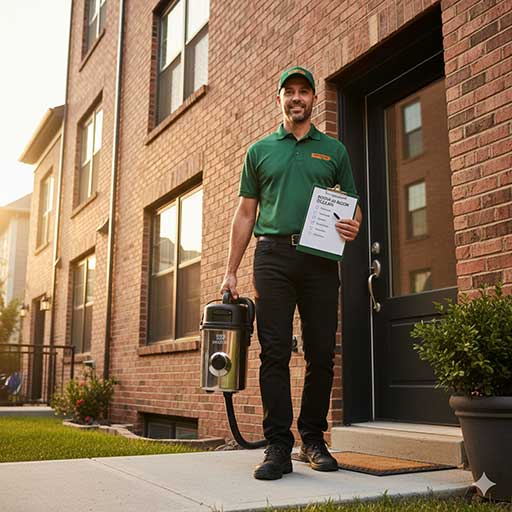
Scope & limits (disclaimer)
This is informational content about professional deep-cleaning practices. It avoids proximity phrasing and calls-to-action and does not route to bookings (no phone prompts/ZIP finders/links). It provides no medical advice and does not recommend specific products or make pathogen-specific efficacy claims. Brand names (e.g., “Servpro”) are descriptive only; no endorsement or affiliation is implied.
What a deep-clean visit typically covers
Teams generally work from a written scope and a room-by-room checklist:
- Kitchen: degreasing of hobs/hoods, backsplashes, appliance exteriors; interiors if pre-agreed; handles and other high-touch points.
- Bathrooms: soil removal, mineral build-up reduction, non-remediation mildew cleaning, ventilation grilles, fixtures, and switches.
- Floors & textiles: HEPA-rated vacuuming; where scoped, low-moisture upholstery/carpet extraction.
- High-touch disinfection: door handles, rails, switches, desk edges, and similar surfaces, following product-label contact times.
Exact tasks depend on the written scope agreed with the provider.
Disinfection protocols (methods, not marketing)
A common sequence is pre-clean → apply disinfectant → respect contact time → avoid cross-contamination (e.g., color-coded cloths; separate tools for bathrooms vs kitchens). Providers typically select products appropriate to the surface and label. No pathogen-specific efficacy is claimed here, and this page does not recommend products; confirm product selection and instructions with the provider.
Senior-friendly adjustments (non-medical)
Where households include older adults or people with limited mobility, crews often adapt: long-reach dusters, low-splash application, slip-aware floor care where appropriate, low-odor/fragrance-free options on request, and extra focus on high-touch zones (banisters, appliance handles, taps). These are operational adjustments — not medical or remediation services.
Planning & expectations (neutral)
Rather than proximity promises or timelines, align on a written scope, an availability window, and any sensitivities (e.g., fragrance-free preferences, ventilation, focus on grab bars). Agree in advance if interiors (e.g., oven, fridge) or soft-surface work are included. Keep expectations procedural, not outcome-based.
Quality you can review
Many providers increase transparency by using:
- a brief walk-through to set priorities and note delicate surfaces,
- a visible task checklist during service,
- an end-of-visit summary noting completed items and any care guidance (e.g., recommended dry times).
Policies differ; confirm terms in writing.
Materials & surface care (examples)
“Thorough” ≠ “harsh.” Common practices include:
- pH-appropriate chemistry for stone; non-etch formulas on glass; peroxide blends in bathrooms where suitable; neutralizers after heavy degreasers.
- HEPA capture plus damp-wipe to limit re-aerosolization of fine dust.
- Fragrance-free options on request for sensitive occupants.
Disclose delicate surfaces during the walk-through so they can be protected or skipped.
Illustrative scenarios (not guarantees)
- Move-in / Move-out: deep kitchen/bath; inside appliances if scoped; baseboards; textiles refreshed where included.
- Post-construction dust: multi-pass HEPA plus damp-wipe of horizontals and vents to address fine particulate.
- After a household illness: high-touch cleaning and disinfection by label contact time; soft-surface refresh if included.
- Pet or smoke odor: targeted textile care and odor-control steps using controlled moisture and extraction.
Outcomes vary by materials, soil level, and agreed scope.
What to expect on the day (descriptive flow)
- Access check & walk-through to align on priorities and special surfaces.
- Protection where appropriate (corner guards/floor runners).
- Execution per scope: degreasing, HEPA vacuuming, low-moisture extraction if specified, disinfection by contact time.
- Completion notes: checklist review and any care guidance (e.g., keep a floor dry for a set time).
Actual steps vary by provider and scope.